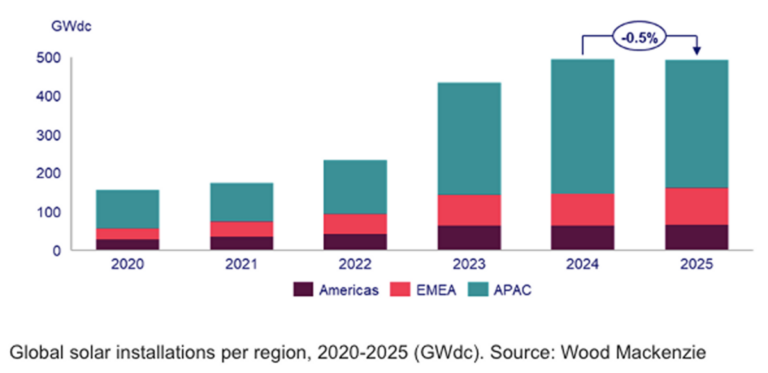The latest report from Wood Mackenzie predicts that this year 493 GW (DC) will be added to solar energy, compared to 495 GW in 2024. The prices of solar modules are expected to rise this year because manufacturers strive for the profit losses of the to make up for the past two years.
According to predictions of Wood Mackenzie, the global solar market is on track to add 493 GW (DC) to solar energy this year. The figure would be a decrease of 0.5% compared to the 495 GW of installed solar energy in 2024.
Sylvia Leyva Martinez, Wood Mackenzie’s chief analyst for solar energy on utility scale in North America, said that the use of solar energy in many countries will slow down as policy changes come to flourish.
“The uncertainty after the elections, declining stimuli, reforms in the energy sector and a shift to less ambitious climate agendas will ensure that solar energy installations stagnate at 493 GWDC after years of exponential growth,” Martinez explains.
The projection is part of the latest report from Wood Mackenzie: “Global solar energy: Four things you should pay attention to in 2025“, Who also predicts that module prices will rise again this year to compensate for the considerable profit losses that manufacturers have suffered.
Yana Hryshko, Managing Consultant and Head of the worldwide research into the Solar Energy Supply Chain for Wood Mackenzie, said that China will remain the dominant production center, while India, the US and the Middle East are expected to add at least 100 GW to the Global production capacity for solar energy.
“Coordination by Chinese manufacturers, supported by the Chinese government, will be the key to achieving rationalization of the industry,” hryshko added.
The report also predicts that the demand for solar energy in data centers will rise as a result of the adoption of artificial intelligence, with Wood Mackenzie currently following more than 100 GW of proposed data centers.
“The question from data centers for sturdy, emission-free capacity will re-shape the origin and development of solar energy projects,” said Martinez. “A larger part of the solar energy projects will be accompanied by wind energy, storage and/or natural gas to meet higher energy needs, and we will see innovation in the field of contractual terms, business models and system architectures. Data centers powered by competition for energy will increase the prices of agreements for the purchase of solar energy. “
Wood Mackenzie also expects technological shifts in the field of solar energy equipment this year. Sagar Chopra, a senior research analyst at Wood Mackenzie, says that the architecture of the voltage converter will increase to 2,000 V (DC), that AI-driven smart trackers will improve efficiency and that robots will increasingly be used in construction and maintenance To tackle the rising labor costs and shortages.
“The decades -long path of continuous improvement of solar technology still has enough room to continue,” Chopra added.
Wood Mackenzie has recently released his ranking of manufacturers of PV modules for the first half of the year, as well as a report on how the Upstream sector could meet the requirements of a delayed energy transition.
This content is protected by copyright and may not be reused. If you want to work with us and reuse part of our content, please contact: editors@pv-magazine.com.


